Just as chatbots are being created for consumers in the hospitality and fast-food industries, technology companies are also serving those restaurants that wish to take advantage of this emerging technology to better their customer service and maximize their productivity—and profitability.
According to the 2017 US Mobile Consumer Report, while “more than half of consumers have yet to see a [chatbot],” 65% would be fully comfortable engaging with a company via chatbot; Vibes, the producer of the report, attributes this to a need for immediacy, as well as the less “intrusive” nature of avoiding human customer service representatives.
While this assertion cannot be fully verified, the growing number of mobile applications used to improve the customer experience is evidence that apps like these should be further monitored as potentially profitable resources for companies looking to provide a more personal experience for their target audience(s).
Over the last year we’ve examined chatbot use cases in healthcare and other sectors; in this article, we have organized five companies targeting restaurant owners, using the same seven quantifiable factors (e.g., funds raised, target user, staff size, etc.) to profile several applications that are gaining traction.
These companies are not ranked, but rather presented as individual entities in alphabetical order.
We’ll conclude by discussing the potential value in connecting with customers via mobile devices and future implications of these applications.
(Note: Readers with a wider interest in machine learning applications in this sector should read our more broad article titled: Machine Learning for Restaurants and Food Services – Examples, Challenges, Trends.)
A Comparison of Current Restaurant Industry Chatbot Applications
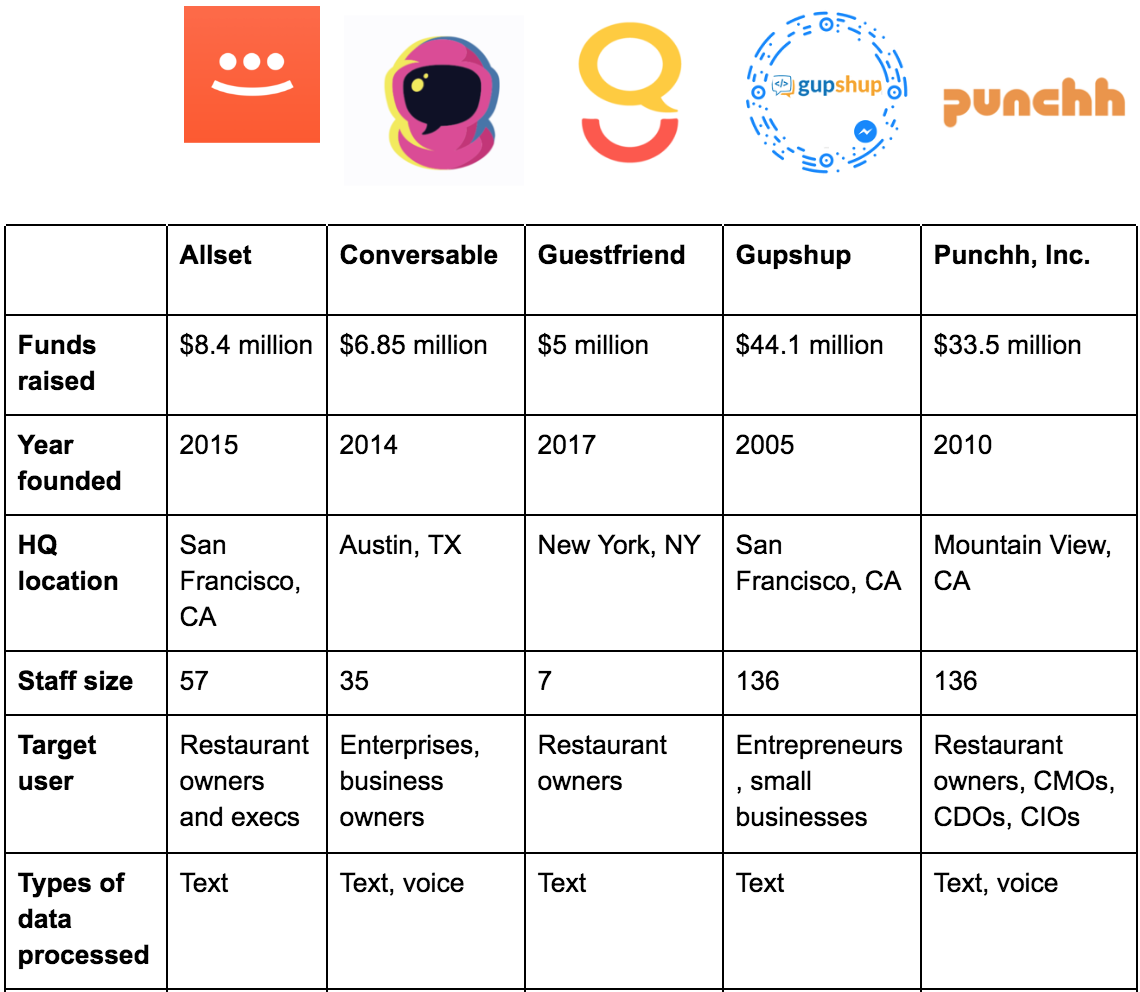
Data collected from Crunchbase, LinkedIn and company websites
These companies are not indicative of all chatbot applications within this market, but we considered the following observations worth noting:
- Two of these five companies process both text and voice data; these companies have been active for 4+ years, but there is no direct correlation between higher amounts of funding and the ability to process both text and voice data.
- All featured companies are based in the United States. Trends and demands may be unique to the country and do not give a global perspective on the development of chatbots for the restaurant industry.
- The range of longevity, staff size, and funds raised among these companies is indicative of the nascent state of the applications in this space. There are no entrenched players – and to a large degree – the ROI of these technologies has yet to be fleshed out in full.
We’ll explore each company in greater depth, with videos and demos wherever applicable:
Allset
- Total funds raised: $8.4 million
- Year founded: 2015
- HQ location: San Francisco, California
- Number of employees: 57
- Target user: Restaurant owners, busy executives
- Type(s) of data processed: Text
- Estimated number of current users: Unspecified
Allset claims to make the dining experience convenient and fast for users by allowing them to use either the Allset application or the Allset Bot to make reservations, order ahead, plus process payment and tip in advance of the guest(s) arrival at their chosen restaurant. Allset Bot is a designed as a more limited iteration of the full-service application, offering to identify restaurants within a specified zip code, make reservations in advance, and giving the user an option to choose from 10 “hand-curated” menu options.
In its video demo, the chatbot is activated by the user typing “Get Started” and “Order Now.” The bot requests the zip code or street you’d like to search for restaurant options. After confirming the location, users scroll through restaurants, choose one, indicate their time of arrival and whether they’d like to order from the pre-selected options shown in the messaging app.
According to their website, restaurant owners could specifically benefit from this service because the orders are pre-paid and pre-tipped, sent in advance of the customer’s arrival, allow for faster turnaround, and could introduce new clientele that may have not had the time to visit before—assuming the potential customers are limited on time during the work day.
The Allset website does not specify whether or not businesses must opt to be included in a search, nor does it detail from where the app pulls data, like available seating, curated menus or approximate wait time. Order information is sent to the restaurant via app, email, text message or fax, so information could be pulled from these receipts; however, the company doesn’t publically indicate whether this data is aggregated into a report or database. Businesses pay Allset a 12% fee per order, plus a processing fee (2.9% + $0.30). Additionally, there is a specific FAQ section for participating business owners.
Conversable
- Total funds raised: $6.85 million
- Year founded: 2014
- HQ location: Austin, Texas
- Number of employees: 35
- Target user: Enterprises, business owners
- Type(s) of data processed: Text, voice
- Estimated number of current users: Unspecified
Conversable claims to be a SaaS platform for designing, building and distributing AI-enhanced messaging and “voice experiences” across multiple platforms, including Facebook Messenger, Twitter and SMS. As detailed by its co-founder and CEO, Ben Lamm, in a June 2016 VentureBeat article, “Conversable doesn’t make bots, it helps companies better communicate with their customers in the messaging channels where their customers already are.” Clients, including eight restaurant chains featured on their site, work with Conversable to create full conversation designs that allow for transactions to be customized for a particular business model.
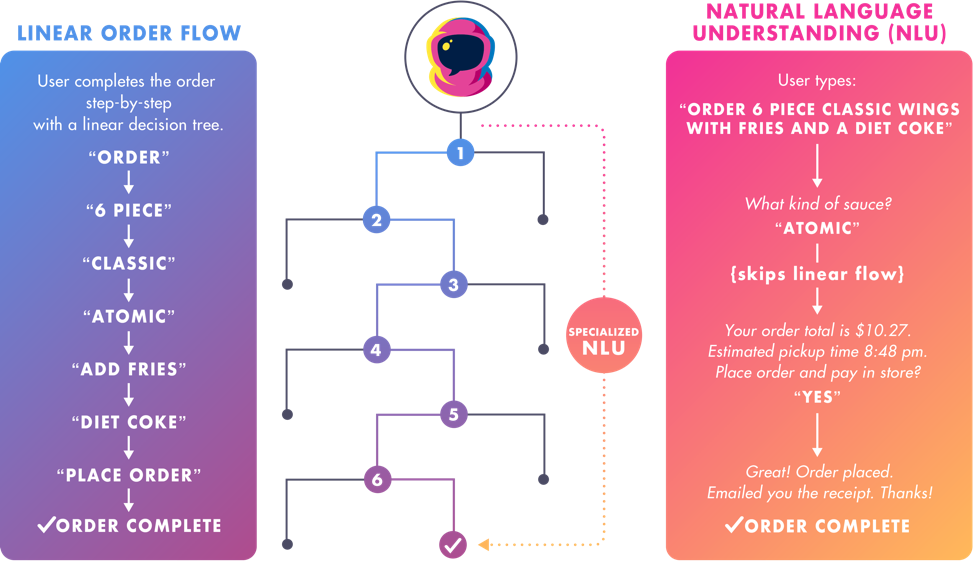
Source: Conversable
For example, TGI Friday’s uses the Conversable platform to allow patrons to make reservations, browse the menu, place orders and search frequently asked questions.
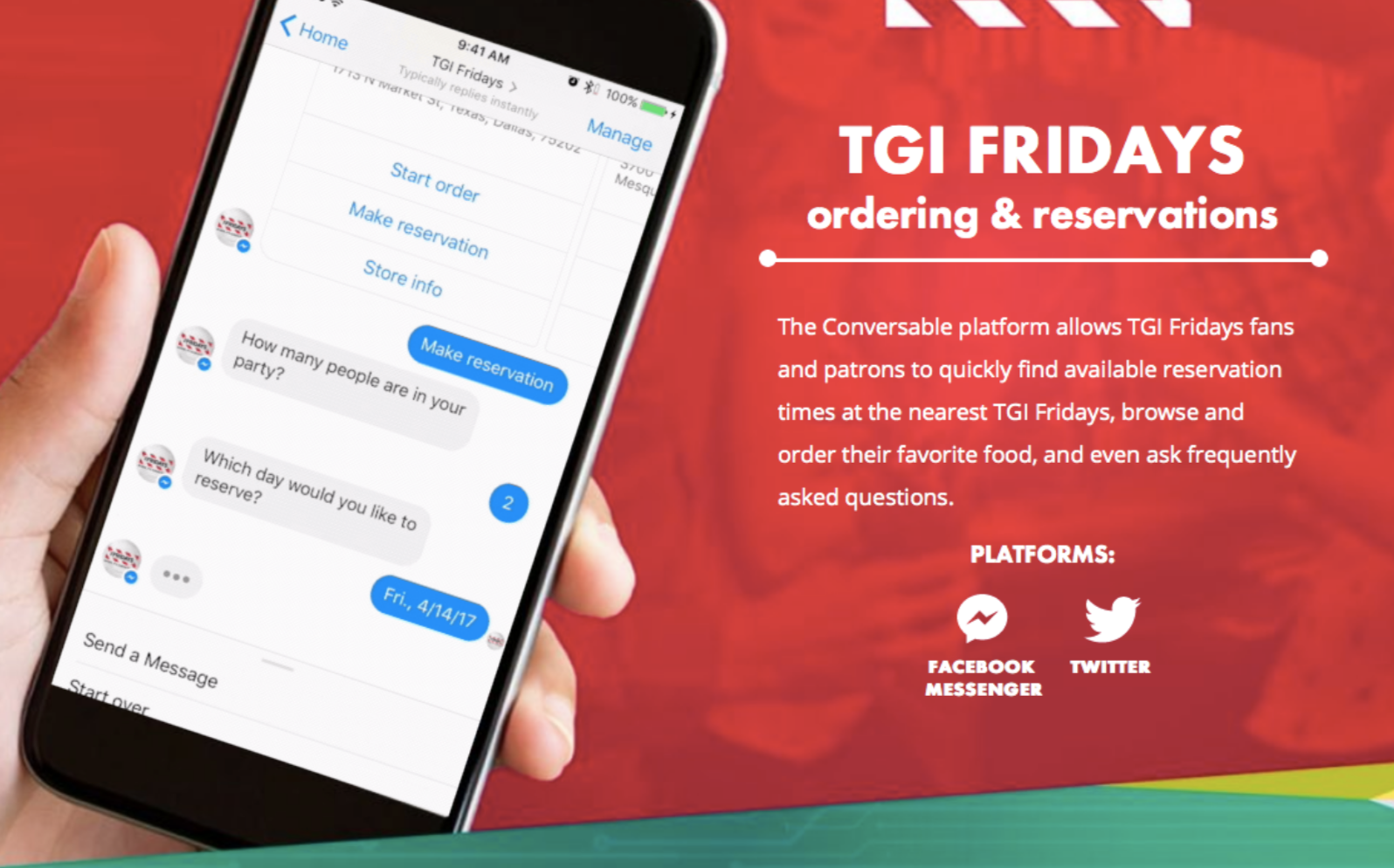
Source: Conversable
The company uses an interactive content editor (“ICE”) to build complex conversational flows. Visuals on the site show conversation mapping being created “from scratch,” requiring the company to write and input all copy.
However, the Answering Questions Using AI (“AQUA”) platform offered by Conversable allows both customizable responses to be programmed by the company, in addition to using language processing to pull what the bot identifies as relevant information and replying to the inquiring user via chat. The resulting metrics are recorded in a live dashboard for the company and identify popular topics and queries from app users.
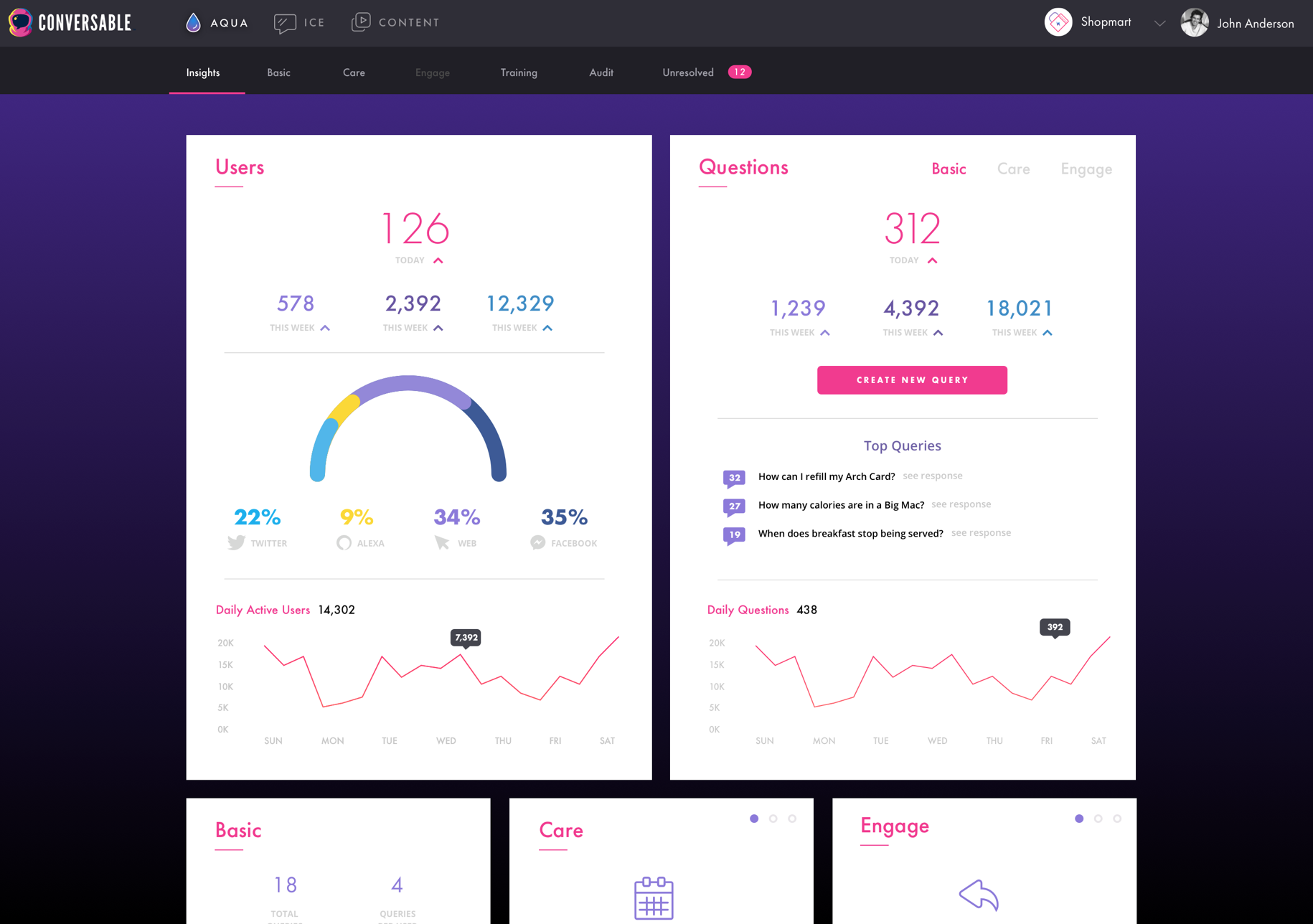
Source: Conversable
Conversable seems to be an in-depth, intensely detailed application appropriate for those businesses who are looking to create personalized messaging and customizable communication flows, rather than those businesses that need a more standardized approach in integrating AI with customer service.
Guestfriend
- Total funds raised: $5 million
- Year founded: 2017
- HQ location: New York, New York
- Number of employees: 7
- Target user: Restaurant owners
- Type(s) of data processed: Text
- Estimated number of current users: Unspecified
Guestfriend claims to build chatbots for small businesses using publicly available data, such as operating hours and a business’ address, which is automatically sourced by the software. Their primary selling point is a providing a “fully customized bot for any small business.”
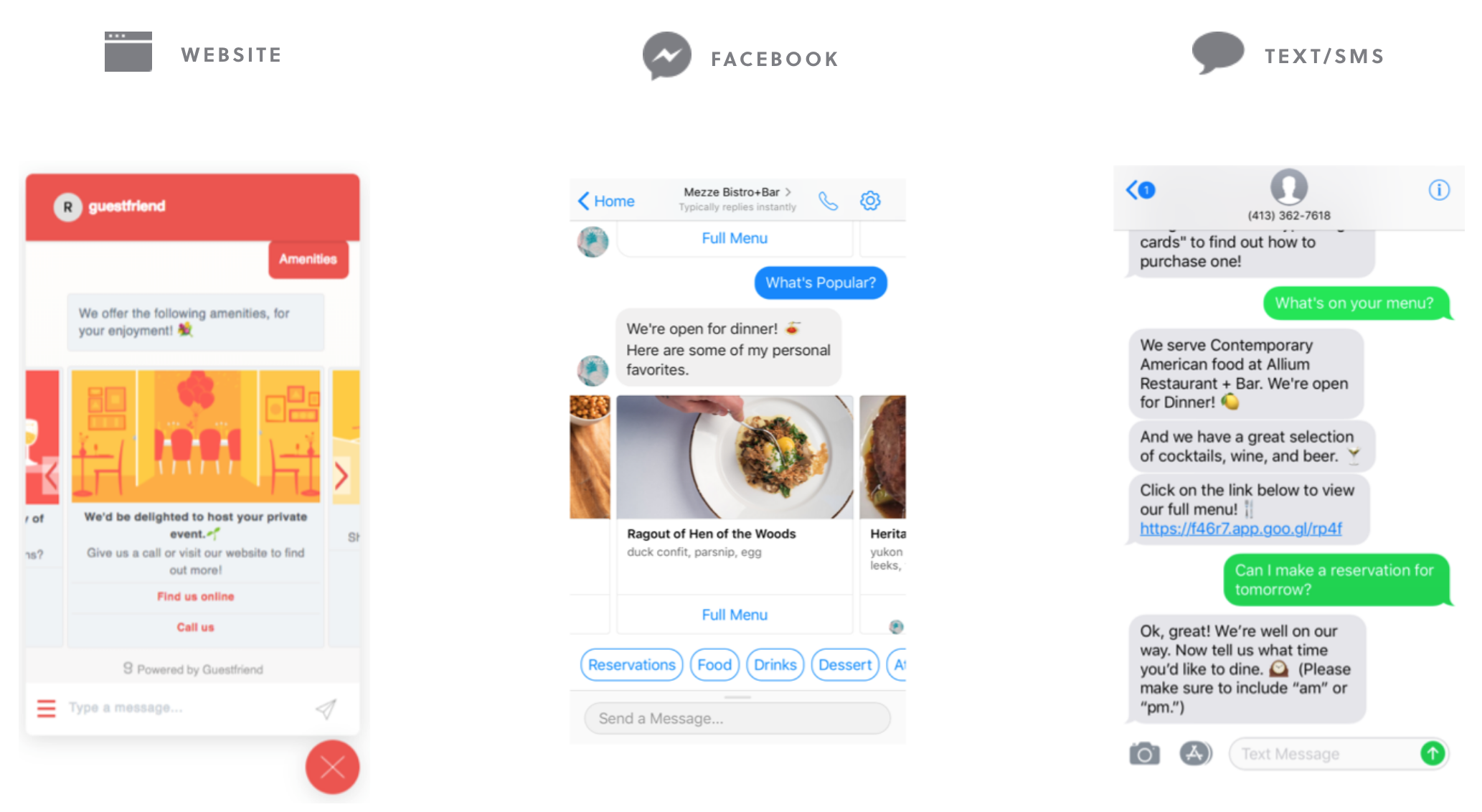
Source: Guestfriend
According to founder and CEO Bo Peabody, their primary audience is currently restaurant owners (a “vertical test”), which may be expanded to include the hospitality industry, among others, in the future.
As outlined on their website, restaurateurs enter their business’ name in a search field on the Guestfriend website, a bot is populated with publicly available information, and the chatbot feature can be integrated into both the restaurant’s website and Facebook page with customizable messaging and images.
The final result appears as a chat feature/SMS box. Demo screenshots on the Guestfriend website show conversations between patrons and the bot through Facebook Messenger, the iPhone messages app and the restaurant’s website, integrating emoji, imagery and hyperlinks.
Specific data on user outcomes is not reported on the site; however, it does list four restaurants as case studies, whose websites you can visit to see the app in action. Additionally, Guestfriend does not detail what the business’ interface/backend dashboard looks like and what data is gathered from users.
Gupshup
- Total funds raised: $44.1 million
- Year founded: 2005
- HQ location: San Francisco, California
- Number of employees: 136
- Target user: Entrepreneurs, small businesses
- Type(s) of data processed: Text
- Estimated number of current users: Unspecified
The Template Bot Builder, created by Gupshup, claims to provide entrepreneurs and small business owners with pre-defined templates using chatbots, connecting them to their target audience(s) and digitizing day-to-day functions. A Business Wire article from November 2, 2016 gives the example of a restaurant owner using a template “that already has food browsing and ordering functionality coded in it.”
Its video demo shows the creation-to-publication process for a restaurant template, where the user first programs in menu options and images, and then demonstrates an interaction between the bot and the customer.
Gupshup’s interface features a dashboard of metrics for individual bots, monitoring health and analytics information for the business owner after the completed template has been finished.
The Template Bot Builder for restaurants does not detail whether it processes voice data, although Gupshup uses this technology in other applications. Therefore, we didn’t include voice data within this specific profile. On the restaurant template page, its primary marketing promises were increased customers (i.e., increased orders) and the ability to “easily manage menu updates.” Little detail was given regarding further programming requirements or costs.
Punchh, Inc.
- Total funds raised: $33.5 million
- Year founded: 2010
- HQ location: Moutain View, California
- Number of employees: 136
- Target user: Restaurant owners, CMOs, CDOs, CIOs
- Type(s) of data processed: Text, voice
- Estimated number of current users: Unspecified
Punchh, Inc. claims to be a fully integrated, transformative marketing solution for restaurants’ loyalty programs. According to a Business Wire article published on March 8, 2017, its chatbot technology integrates into existing point-of-sale systems, loyalty and ordering programs and connects to customers via message and voice-based apps, like Facebook Messenger and Alexa.
Punchh positions itself as serving specifically “brick-and-mortar” businesses, and in addition to marketing to restaurants, also serves convenience stores, gas stations and the health and beauty industry. It is designed with an “end-to-end application lifecycle” and offers connection to a company’s POS, ordering, and email systems via APIs and pre-built integrations.
In its demo/marketing video, the Punch application specifically designed for restaurants focuses on the app’s ability to send timely offers and coupons to customers based on their location, and its rewards programming capabilities. Whereas other apps featured in this article serve to complete transactions, Punchh is marketed as more of a PR tool for businesses.
The company reports a 50% increased frequency in [customer] visits and a 20% increase in customer spend, although no source attribution and further data are paired with these claims. Additionally, little information is given about the design and customization process for the participating restaurant(s).
Concluding Thoughts on Restaurant Chatbots
Further research is necessary to determine the conversion rate of customer interactions with bots to increased sales and brand awareness. While each of the companies featured here promise positive outcomes and ROI for participating restaurants, little to no data is presented to back up these claims. As a caveat, ROI may be difficult to objectively measure for those well-established enterprises and restaurants that already have high brand awareness – and it’s unclear if the novelty appeal of new applications could skew the future ROI of these applications one way or another.
Chatbots processing both text and voice data have the capability of creating unique, immediate interactions between companies and their customers; text data processing is a standard feature in these applications, while voice recognition software seems to be adopted as an enticing, but secondary capability.
Providing further video demos and data to potential customers, especially for those businesses who are looking to make a sizeable investment (relative to their budget) in this technology, could go a long way in transforming public perception of chatbots’ use in customer service and sales from one of hype to one of necessity.
Smaller restaurant conglomerates may view AI technology of this kind as superfluous given the small amount of hard data that accompanies these applications. We suspect that larger restaurant giants with existing tech infrastructure and high volumes of customer data are most likely to take advantage of these technologies in the near term.
An app like Conversable would require high data volumes within a company, as its many functions require personalization and custom copy. Applications that source some publicly available information, like Guestfriend, may be more attractive to restaurants/companies with less need for customized information and input, though it’s unclear as to how transferrable different customer requests and replies are from company to company.
Finally, these applications approach their target audience through various approaches (templates, custom communication plans, automatic population of publicly available data); more research and data collection is necessary to determine which of these methods is preferred by different sectors of the restaurant industry. Making chatbots and AI useable and accessible to non-data scientists is no easy task, and this level of access will be extremely important in the competition in the market for these applications.
Header image credit: Vip Lounge


















